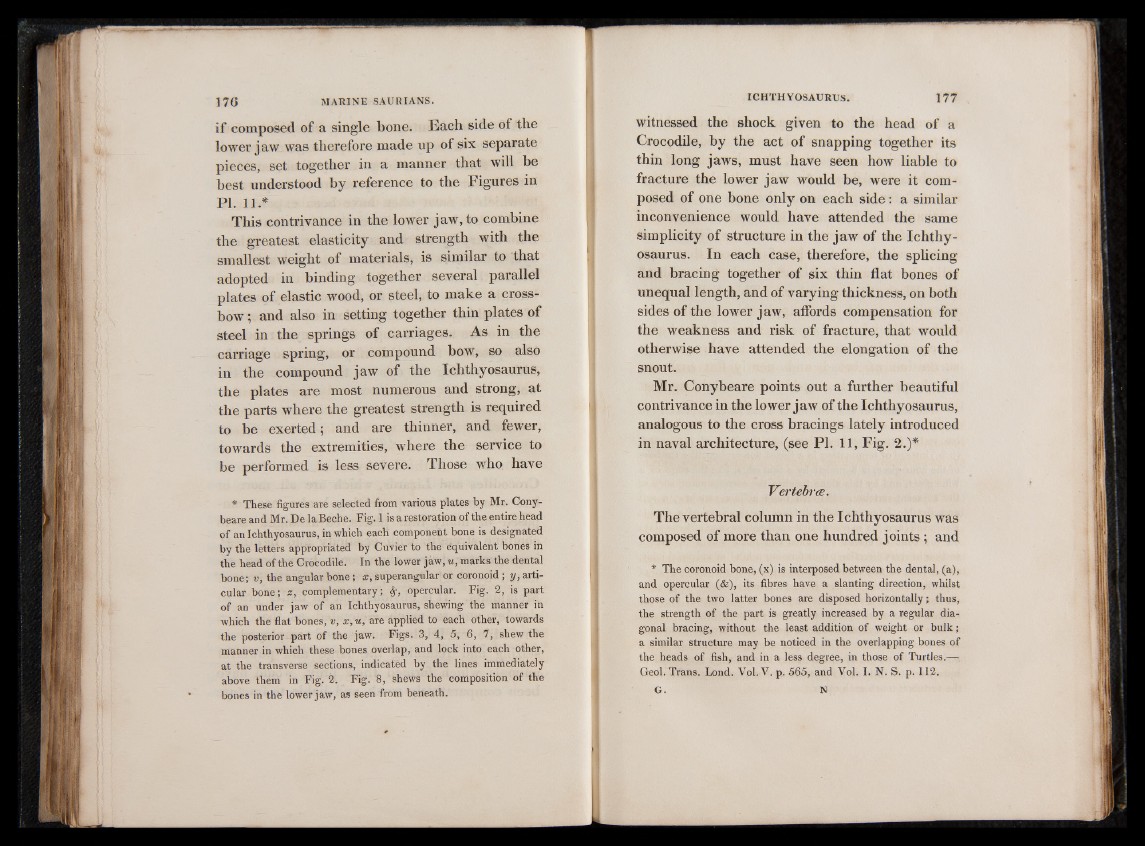
if composed of a single bone. Each side of the
lower jaw was therefore made up of six separate
pieces, set together in a manner that will he
best understood by reference to the Figures in
PI. 11.*
This contrivance in the lower jaw, to combine
the greatest elasticity and strength with the
smallest weight of materials, is similar to that
adopted in binding together several parallel
plates of elastic wood, or steel, to make a crossbow
; and also in setting together thin plates of
steel in the springs of carriages. As in the
carriage spring, or compound bow, so also
in the compound jaw of the Ichthyosaurus,
the plates are most numerous and strong, at
the parts where the greatest strength is required
to be exerted; and are thinner, and fewer,
towards the extremities, where the service to
be performed is less severe. Those who, have
* These figures are selected from various plates by Mr. Cony-
beare and Mr. De la Beche. Fig. 1 is a restoration of the entire head
of an Ichthyosaurus, in which each component bone is designated
by the letters appropriated by Cuvier to the equivalent bones in
the head of the Crocodile. In the lower jaw, u, marks the dental
bone; v, the angular bone; x, superangular or Coronoid ; y, articular
bone; z, complementary; 8f, opercular. Fig. 2, is part
of an under jaw of an Ichthyosaurus, shewing the manner in
which the flat bones, v, x, u, are applied to each other, towards
the posterior part of the jaw. Figs. 3, 4, 5, 6, 7, shew the
manner in which these bones overlap, and lock into each other,
at the transverse sections, indicated by the lines immediately
above them in Fig. 2. Fig. 8, shews the composition of the
bones in the lower jaw, as seen from beneath.
witnessed the shock given to the head of a
Crocodile, by the act of snapping together its
thin long jaws, must have seen how liable to
fracture the lower jaw would be, were it composed
of one bone only on each side : a similar
inconvenience would have attended the same
simplicity of structure in the jaw of the Ichthyosaurus.
In each case, therefore, the splicing
and bracing together of six thin flat bones of
unequal length, and of varying thickness, on both
sides of the lower jaw, affords compensation for
the weakness and risk of fracture, that would
otherwise have attended the elongation of the
snout.
Mr. Conybeare points out a further beautiful
contrivance in the lower jaw of the Ichthyosaurus,
analogous to the cross bracings lately introduced
in naval architecture, (see PI. 11, Fig. 2.)*
Vertebra.
The vertebral column in the Ichthyosaurus was
composed of more than one hundred joints; and
* The coronoid bone, (x) is interposed between the dental, (a),
and opercular (&), its fibres have a slanting direction, whilst
those of the two latter bones are disposed horizontally; thus,
the strength of the part is greatly increased by a regular diagonal
bracing, without the least addition of weight or bulk;
a similar structure may be noticed in the overlapping bones of
the heads of fish, and in a less degree, in those of Turtles.—
Geol. Trans. Lond. Vol.-V. p. 565, and Vol. I. N. S. p. 112.
G. N